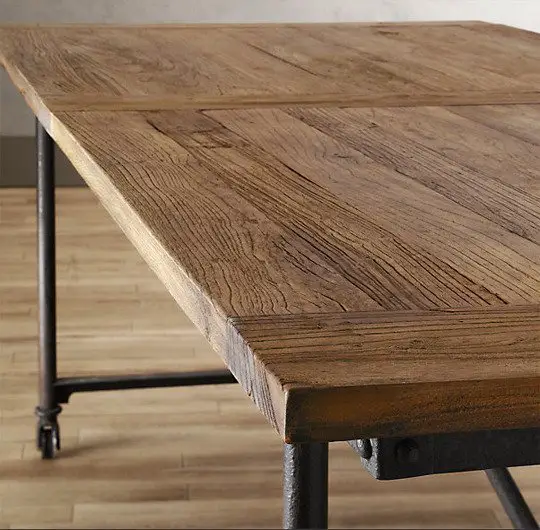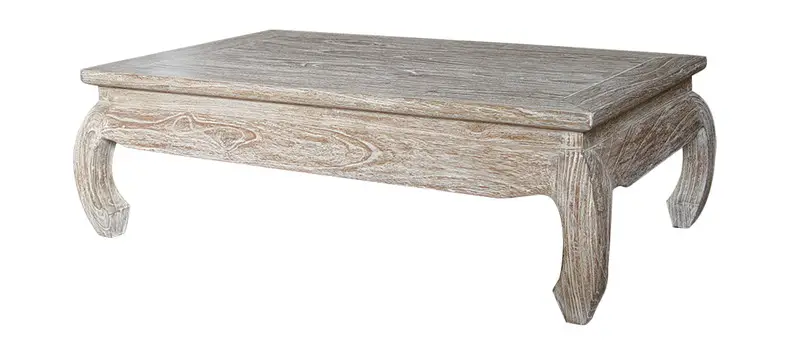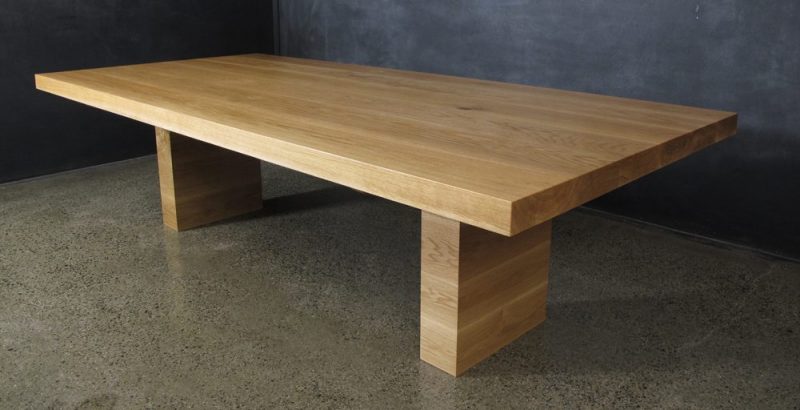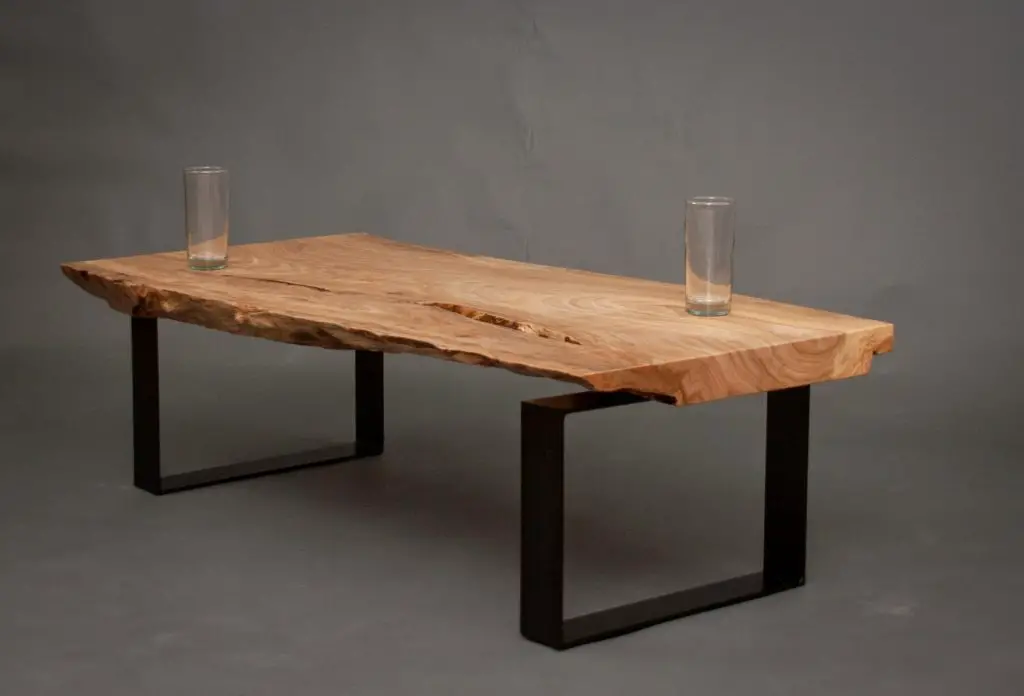Solid wood tables with metal legs and a natural finish continue to be a big hit. The style is called rustic industrial, and the finish is called natural effect. The purpose of this type of finish is quite obvious - to preserve the natural appearance of the wood by an almost imperceptible finish, but which offers protection and resistance to scratching or other mechanical action.
Tables with simple design and discreet colors
Tables with this finish are very simple in appearance. The main element is the tabletop, made from a thick plank or solid wood carpet. Hardwood is used, such as oak, maple, acacia, but it's not out of the realm of the possible pin. The top rests on simple but sturdy wooden or metal legs.
When not left natural, the color applied to the countertop is as close to natural as possible. Popular colors include the grey of weathered wood or shades such as honey or washed white. In this type of finish, nothing is overdone, everything should be natural and authentic.


Strong protection, but as inconspicuous as possible
Tables are pieces of furniture that are subject to all kinds of aggression: stains with hot or aggressive liquids (alcohol), scratches, knocks. The materials used to produce the natural effect should protect the table, but be as inconspicuous as possible. The natural rustic effect can be achieved by using wax or oil, but they will not provide the protection you need. The most suitable are solvent-based acrylic varnishes, with very low hardeners and gloss below 5. Acrylic lacquers are very resistant to direct light, which will prevent the finish from changing color over time and yellowing.
In order to avoid the film from being visible, apply as little material as possible. One coat of acrylic primer and one coat of acrylic varnish are recommended. After drying, the primer should be sanded with 280-320 grit sandpaper and carefully sanded so that no dust remains in the pores of the wood. The recommended grammage is 100-110 g/m² material remaining on the board, both for primer and varnish. By respecting the applied quantity and sanding between coats, the natural effect of the finish is guaranteed.
Such tables fit into any space. Their simple, natural style blends in well whether the interior is classic or modern. They blend well in minimalist spaces or futuristic offices.


Whether you are a manufacturer of such tables, solid wood or veneered panel furniture, always make sure you use the right products. It is important that the supplier of finishing materials you work with not only has quality products and ideas, but also solutions and experience.
If you have any questions about the wood finish or are unsure about some materials, leave a message in the comments area! I'll be sure to reply.



































A work a bowl, a plate, a vase or whatever made on a lathe from a green wood of apple, plum, walnut or acacia, how can I keep them [treat] not to crack??????I expect an answer .....virgil coco .THANK YOU .
Being wet, the wood will be tempted to lose water and so will end up cracking. The harder the wood, the greater the stresses created by water loss. The hardest wood is acacia. It is best to keep the wood away from large temperature variations. You can apply layers of primer and varnish to block any moisture exchange with the outside. That means apply 3-4 coats of primer, with sanding in between, then apply a final coat of varnish. The first coat of primer is applied thinner so that it gets into the wood as much as possible. And so protected, if it is not protected from large temperature variations, it can still crack due to internal tensions created in the wood. I have heard of a traditional method of protection but I have not tried it. The wood is treated with a sugar solution 1-5%. Substances against insects and mould are added to the solution. Wooden objects are kept in this solution for 10-15 minutes for a few days at a time, after which they are wiped off and placed in a place out of the sun or cold. Objects can also be treated with silicone oil. I wish you good luck.
oils?
Oil does not prevent moisture exchange between wood and the environment. The wood will dry slowly and if it is not subjected to shocks (large differences in temperature and humidity) drying takes place without any consequences (cracking). Oil protects very well when it rains, for example. Water simply runs off and does not penetrate the wood. This is why fences and windows were once treated with linseed oil or, later, transformer oil.
Hello, I want to congratulate you for all the interesting articles on this site!
I also have a question, I want to make a live-edge table out of walnut, I have the wood already dried in the kiln, I know pretty much everything I need to do (finishing, dove-tail joints on cracks, maybe epoxy on fine cracks etc.), but I don't know what product to use for finishing. I exclude wax or oil, although I want it to look as natural as possible, they don't offer mechanical protection. I understand from your article that the most suitable would be acrylic varnishes, but could you not simply recommend me a good product for that, because when I go to the shop I get lost among so many products. I would like if it is possible and not against the policy of the site an answer like: lacquer X from company Y. Thank you!
Hello. Do you have a recommendation for a matt varnish that does not change the colour of the wood? I need it for some countertops and steps. Thank you!
Hello!
You can use solvent-based acrylic varnishes or water-based varnishes, with a gloss level up to 10. You can find them at wood finishing retailers, except DIY stores. There are such distributors all over the country. Well-known brands that also carry the products you are interested in are Sirca, ICA (Lomilux), Renner, Sayerlack, Milesi.
All the best!
Hello!
I need some advice, please. I have a round slice of freshly sliced walnut wood and want to make a coffee table out of it. It is approx 60 cm in diameter and about 6-7 cm thick. What would be the correct process? How long should it be left to dry, under what conditions and then with what and how should it be treated so it doesn't crack? I mention that I would like to process it fairly quickly and the final colour to be as close to natural as possible. I accept any solutions from you thank you in advance!
Hello!
Roundwood is the fastest and safest to crack because the wood varies most dimensionally in radial and tangential directions. That's why they need different treatments to temper this tendency. Below you have 3 links where you can find complete information about treating roundwoods so they don't crack, methods to stabilize green wood and different solutions used by carpenters to avoid cracks.
Good luck!
https://revistadinlemn.ro/2023/01/26/cum-sa-eviti-craparea-rondelelor-de-lemn/
https://revistadinlemn.ro/2018/06/13/stabilizarea-lemnului-verde-pentru-evitarea-craparii/
https://revistadinlemn.ro/2022/06/23/ce-solutii-au-tamplarii-pentru-reducerea-craparii-lemnului-la-capetele-bustenilor-grinzilor-si-scandurilor/